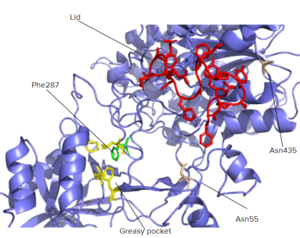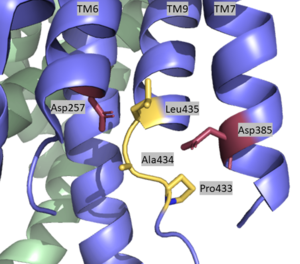Sandbox Reserved 1619
From Proteopedia
(Difference between revisions)
| Line 20: | Line 20: | ||
===Substrate Structure=== | ===Substrate Structure=== | ||
Though gamma secretase has multiple substrates, the substrate of main concern is called Amyloid Precursor Protein (APP). APP is composed of an N-terminal loop, a transmembrane (TM) helix, and a C-terminal β-strand. The uses lateral diffusion as a mechanism of entry into the enzyme, and once in place, the TM helix is anchored by hydrogen bonds. In order to differentiate substrates, the β-strand is often the main point of identification for the enzyme. After this, the helix undergoes unwinding and the process of catalysis can begin. | Though gamma secretase has multiple substrates, the substrate of main concern is called Amyloid Precursor Protein (APP). APP is composed of an N-terminal loop, a transmembrane (TM) helix, and a C-terminal β-strand. The uses lateral diffusion as a mechanism of entry into the enzyme, and once in place, the TM helix is anchored by hydrogen bonds. In order to differentiate substrates, the β-strand is often the main point of identification for the enzyme. After this, the helix undergoes unwinding and the process of catalysis can begin. | ||
| + | |||
===Lid Complex=== | ===Lid Complex=== | ||
| + | [[Image:777.png|300 px|right|thumb|Lid Complex of Gamma Secretase]] | ||
Lid is the first point of entry and recognition for the substrate. This lid complex is located within the NCT subunit between Asn55 and Asn435. This lobe is divided into two separate subunits, and Phe287 from large lobe acts as pivot between them. This Phe is further surrounded by Phe103, Leu171, Phe176, and Ile180 of the small subunit, and these residues compose a greasy pocket for that provides an environment for easy movement. The lid consists of 5 aromatic residues which are highly involved with stabilizing the closed conformation. In particular, this conformation is stabilized by Trp164, which has interacts with Pro424, Phe448, and the aliphatic side chain of Gln420. Once the substrate binds and the lid is opened, a charged, hydrophilic pocket is revealed. This pocket contains Glu333 and Tyr337 surrounded by several charged residues, and is involved with further substrate binding and recognition. | Lid is the first point of entry and recognition for the substrate. This lid complex is located within the NCT subunit between Asn55 and Asn435. This lobe is divided into two separate subunits, and Phe287 from large lobe acts as pivot between them. This Phe is further surrounded by Phe103, Leu171, Phe176, and Ile180 of the small subunit, and these residues compose a greasy pocket for that provides an environment for easy movement. The lid consists of 5 aromatic residues which are highly involved with stabilizing the closed conformation. In particular, this conformation is stabilized by Trp164, which has interacts with Pro424, Phe448, and the aliphatic side chain of Gln420. Once the substrate binds and the lid is opened, a charged, hydrophilic pocket is revealed. This pocket contains Glu333 and Tyr337 surrounded by several charged residues, and is involved with further substrate binding and recognition. | ||
| - | |||
Revision as of 22:27, 30 March 2020
Gamma Secretase
| |||||||||||
References
- ↑ Bai XC, Yan C, Yang G, Lu P, Ma D, Sun L, Zhou R, Scheres SH, Shi Y. An atomic structure of human gamma-secretase. Nature. 2015 Aug 17. doi: 10.1038/nature14892. PMID:26280335 doi:http://dx.doi.org/10.1038/nature14892
Student Contributors
Layla Wisser
Daniel Mulawa


